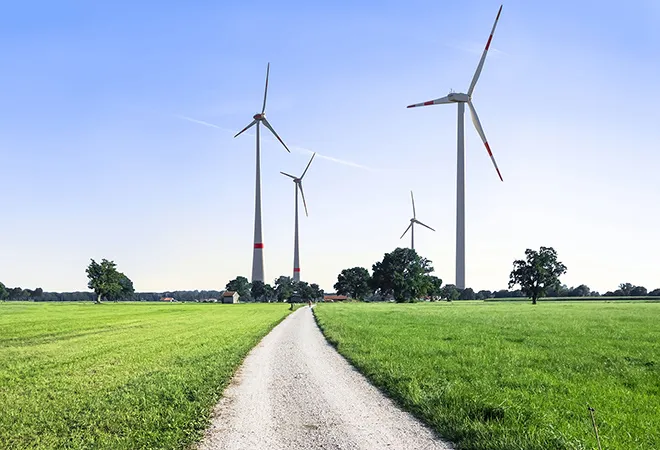Climate finance, or Green Money, remains a critical bottleneck for India in its journey towards the Net Zero 2070 objective and to create a resilient system through climate adaptation and mitigation. The challenge is daunting—to make a climate transition for a nation of 1.4 billion people with increasing aggregate national income and individual wealth inequality. Finances for climate change were to be channelised through multi-tiered systems in the form of national, regional, and international bodies. It has been estimated that India will need $15 trillion to finance its Net Zero journey.
Finances for climate change were to be channelised through multi-tiered systems in the form of national, regional, and international bodies.
In most cases, small amounts flowing now into the developing component of the G20 nations are actually in the form of concessional loans rather than grants. There is no doubt that India will need international financial commitments and technological support from developed countries, who have been erratic with their promised deliveries so far.
As for domestic financial sources, according to an
RBI Bulletin from January 2021, “… green finance in India is still at the nascent stage. Green bonds constituted only 0.7% of all the bonds issued in India since 2018, and bank lending to the non-conventional energy constituted about 7.9% of outstanding bank credit to the power sector as on March 2020.” The report also mentioned that the development of green financing and funding of environment-friendly sustainable development is not without challenges, which may include false compliance claims, misuse of green loans, and, most importantly, maturity mismatches between long-term green investments and relatively short-term interests of investors. Another research report indicates that banks in India, like in many parts of the world, are not prepared to adapt to climate change; and have not yet factored in any climate-related financial risks into their day-to-day decision-making. Some of the criteria used to assess the banks include a commitment to phase out investments in coal, disclosing and verifying direct and indirect emissions, issuing green loans, financing climate mitigation, and Net Zero targets for different types of emissions and their implementation plans. The report is also critical that none of the 34 banks have tested the resilience of their portfolios in the face of climate change. Yet, the bankers’ noise around the green finance topic is euphorically loud, without action.
However, the Indian market lacks the depth of its debt markets or the heft of the bond markets.
These banks and financial institutions are also not geared up for financing green transition. First, India faces the big challenge of “how to define green”, as there is no uniform green definition and green taxonomy barring an ORF attempt. Second, the green money is generated through largely debt-based products (green bonds, climate policy performance bonds, debt for climate swaps, etc), while the fund deployment occurs through debt-based, equity-based, and often, insurance-based instruments, apart from grants and loans. However, the Indian market lacks the depth of its debt markets or the heft of the bond markets. Third, there is an inherent problem with “green data governance” that entails tracking the entire data-chain of a green financing initiative. Fourth, like many other private sector funding, the banks look at rates of return that do not really often make financing “public goods” as viable investments. They are even apprehensive about financing projects with long gestation periods with uncertain returns.
An economic return alone might not be sufficient to induce green financing. A more holistic rate of return, considering the social cost of carbon, will be appropriate. A longer time horizon will be needed for the cost-benefit analysis and the estimation of the return on investment. This is because, for climate-related projects, the returns increase over time. Next, the extent to which the particular project could result in CO2 reduction and, eventually reduction in the social cost of carbon need to be assessed.
As an example, India intends to reduce 1 billion tonnes of CO2. The present social cost of CO2 (SCC) is $86/tonne. Therefore, the sheer economic gain is to the tune of $86 billion, or 2.1% of the current Indian GDP. Social cost saving is a public good and is enjoyed by all businesses, including the financial institutions. Hence, for a stronger business case for climate finance, we propose to include in its RoI calculations the cost-benefit returns of the project through NPVSCC20—the Net Present Value of Social Cost of Carbon over 25 years of the project, a time period that compares well with tenor of infra and sovereign bonds. As an incentive, the government could introduce taxation sops for using NPVSCC25.
A longer time horizon will be needed for the cost-benefit analysis and the estimation of the return on investment.
The way India finances its journey to Net Zero 2070 could very well be a framework for other nations, for it would need to have contours of social inclusion, economic flexibility, and sustainable financing, while keeping in mind the political compulsions, as well as serving the demographic requirements of creating and sustaining livelihood in decades to come. Therefore, financial institutions need to drastically up their green-thinking, while India looks at foreign partnerships and global financial sources for such financing. If demonetisation was a big step for the Indian economy, we now need a remonetisation in the form of green finance.
This commentary originally appeared in Financial Express.
The views expressed above belong to the author(s). ORF research and analyses now available on Telegram! Click here to access our curated content — blogs, longforms and interviews.




 PREV
PREV


